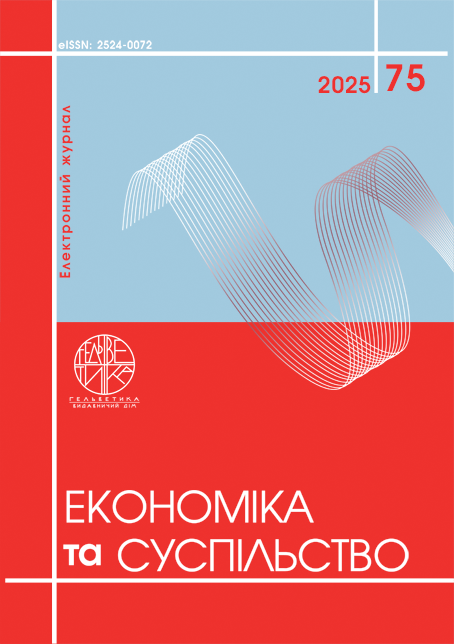DEVELOPMENT OF THE POTENTIAL OF CONSTRUCTION ENTERPRISES IN THE CONDITIONS OF DIGITALIZATION
Abstract
This article is devoted to the topical issues of ensuring the development of the potential of enterprises in the construction industry through the introduction of digital technologies. Taking into account the global trends of digitalization, the essence of digital technologies and their capabilities in the field of ensuring the development of the potential of enterprises in the construction industry were analyzed, which allowed us to establish the advantages and disadvantages of their use. In the context of the innovative development of enterprises in the construction industry, the implementation of a modern approach to optimizing design and construction processes, namely BIM (Building Information Model) technology, was studied in detail. The activation of the use of BIM technologies is an important step towards the digitalization of the construction industry, however, in our country, the experience of implementing BIM technologies is quite limited, unlike in highly developed countries. Based on world practices, it can be argued that it is advisable to use BIM not only for the construction of new buildings, but also for the reconstruction of existing ones, including those damaged by military operations. Thus, a conclusion is made about the introduction of BIM technologies as an innovative and one of the most effective tools for the reconstruction of our country. Considerable attention is focused on the economic feasibility of implementing BIM technologies, both for new construction and for the reconstruction of buildings. Thus, BIM has the greatest impact on preventing construction schedule delays and preventing rework due to early model assessment. In the work, the construction information model is interpreted as a flexible model that integrates the participation of all those involved in the construction process at each stage. The issue of the complexity of implementing BIM design at the current stage is considered, and the methodology for creating an effective BIM concept is described. A key factor in ensuring the development of the potential of construction companies is the development and approval of a company's digital transformation strategy. To do this, it is important that both management and employees understand the value and strategic goals of digital change.
References
Верхоглядова Н.І., Коваленко-Марченкова Є.В. Складові потенціалу будівельної галузі як основа його конкурентоспроможності. Причорноморські економічні студії. 2017. Вип. 15. С. 36–39.
Кірієнко Д.О., Шиляєва О.С. BIM: історія розвитку і перспективи впровадження. Вісник Одеської державної академії будівництва та архітектури. 2017. Вип. № 67. С. 32–36.
Кулик М.В., Куліш С.О., Іщенко С.С. Впровадження новітніх цифровізованих програмних комплексів на базі BIM-технологій у будівництві України. Науковий вісник будівництва. Сер. Будівництво. 2020. № 2. С. 301–306.
Трач Р.В. Переваги застосування концепції інформаційного моделювання в будівництві. Ресурсоекономні матеріали, конструкції, будівлі та споруди. 2018. № 36. С. 288–294.
Digital Capital Projects. URL: https://dedalsoft.com.ua/blog/tsifrovizatsiya-budivelnoi-galuzi (дата звернення: 20.05.2025).
Верховна Рада України прийняла за основу законопроєкт щодо запровадження будівельного інформаційного моделювання (BIM-технологій). URL: https://www.rada.gov.ua/news/radanews/225312.html (дата звернення: 29.05.2025).
Ліга.net. Як BIM змінить девелопмент та Real Estate в Україні. URL: https://blog.liga.net/user/sguzenko/article/yak-bim-zminit-development-ta-real-estate-v-ukraini (дата звернення: 30.05.2025).
Kharkiv IT Cluster. VEC-UA: Віртуальне будівництво або технологія майбутнього. URL: https://it-kharkiv.com/vec-ua-virtualne-budivnitstvo/ (дата звернення: 29.05.2025).
Verkhohliadova N.I., Kovalenko-Marchenkova Ye.V. (2017) Skladovi potentsialu budivelnoi haluzi yak osnova yoho konkurentospromozhnosti [Components of the potential of the construction industry as the basis of its competitiveness]. Prychornomorski ekonomichni studii, vol. 15, pp. 36–39.
Kiriienko D.O., Shyliaiev O.S. (2017) BIM: istoriia rozvytku i perspektyvy vprovadzhennia [BIM: history of development and prospects for implementation]. Visnyk Odeskoi derzhavnoi akademii budivnytstva ta arkhitektury, vol. 67, pp. 32–36.
Kulyk M.V., Kutsish O., Ishchenko S.S. (2020) Vprovadzhennia novitnikh tsyfrovizovanykh prohramnykh kompleksiv na bazi BIM-tekhnolohii u budivnytstvi Ukrainy [Introduction of the latest digitalized software packages based on BIM technologies in the construction of Ukraine]. Naukovyi visnyk budivnytstva. Ser. Budivnytstvo,vol. 2, рр. 301–306.
Trach R.V. (2018) Perevahy zastosuvannia kontseptsii informatsiinoho modeliuvannia v budivnytstvi [Advantages of using the concept of information modeling in construction]. Resursoekonomni materialy, konstruktsii, budivli ta sporudy, vol. 36, pp. 288–294.
Tsyfrovizatsiya budivelʹnoyi haluzi: perevahy ta vyklyky [Digitization of the construction industryadvantages and challenges]. Available at: https://dedalsoft.com.ua/blog/tsifrovizatsiya-budivelnoi-galuzi (accessed May 20, 2025).
Verkhovna Rada Ukrainy pryiniaka za osnovu zakonoproiekt shchodo zaprovadzhennia budivelnoho informatsiinoho modeliuvannia (BIM-tekhnolohii). [The Verkhovna Rada of Ukraine adopted a draft law on the introduction of building information modeling (BIM technologies)]. Available at: https://www.rada.gov.ua/news/radanews/225312.html (accessed May 29, 2025).
Liha.net. Yak BIM zminyt development ta Real Estate v Ukraini [How BIM will change development and Real Estate in Ukraine]. Available at: https://blog.liga.net/user/sguzenko/article/yak-bim-zminit-development-ta-real-estate-v-ukraini (accessed May 30, 2025).
Kharkiv IT Cluster. VEC-UA: Virtualne budivnytstvo abo tekhnolohiia maibutnoho. [VEC-UA: Virtual construction or technology of the future]. Available at: https://it-kharkiv.com/vec-ua-virtualne-budivnitstvo/ (accessed April 12, 2025)

This work is licensed under a Creative Commons Attribution 4.0 International License.


